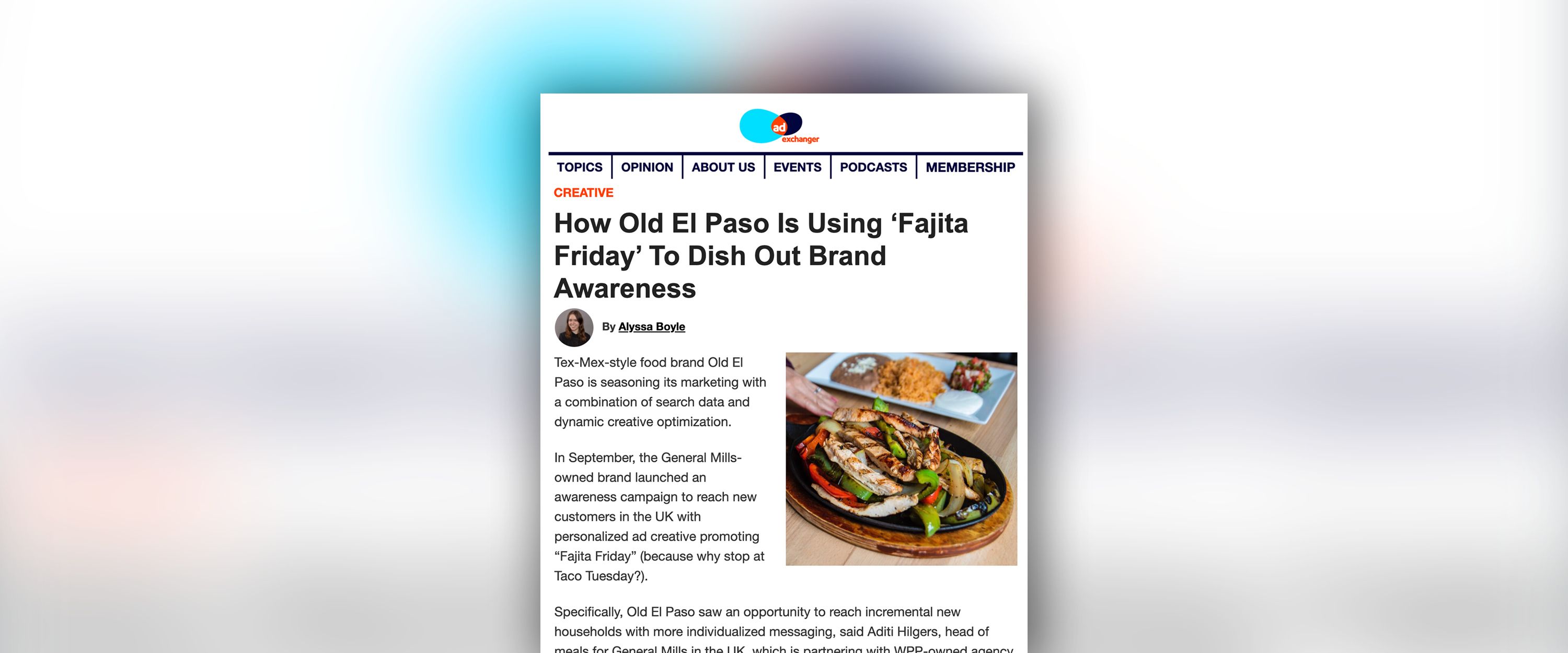AdExchanger: How Old El Paso Is Using ‘Fajita Friday’ To Dish Out Brand Awareness
Extracted from AdExchanger, Author Alyssa Boyle
Tex-Mex-style food brand Old El Paso is seasoning its marketing with a combination of search data and dynamic creative optimization.
In September, the General Mills-owned brand launched an awareness campaign to reach new customers in the UK with personalized ad creative promoting “Fajita Friday” (because why stop at Taco Tuesday?).
Specifically, Old El Paso saw an opportunity to reach incremental new households with more individualized messaging, said Aditi Hilgers, head of meals for General Mills in the UK, which is partnering with WPP-owned agency Mindshare and search intelligence company Captify on the campaign.
Old El Paso has been in the UK since the 1980s. (It first launched in the 1930s, selling meal kits to make traditional Mexican meals, like tacos, more accessible to people in the US.)
The Fajita Friday campaign has three different variations of ad creative and copy, which include static and video versions. Different Fajita Friday ads are served based on user search.
This level of creative optimization “isn’t something we’ve been able to do before,” Hilgers said.
Creative recipe
Search is typically intent-driven, meaning people are actively looking for something.
You are what you eat and, well, you are what you search for online.
Search is the first “exploratory” step toward purchase intent, said Steve Pereira, president of Captify’s UK business.
Captify works with publishers and data management platforms to track 40 billion monthly search events across roughly 2 billion users. Through integrations with demand-side platforms, Captify can use this data to inform which variation of an ad someone sees in real time, Pereira said.
Captify segments search data into categories, such as “family dinner” or “date night,” which it uses to help determine which of the three Fajita Friday ad creative/copy combinations Mindshare helped produce is most appropriate for a specific audience.
Users who search for a phrase like “easy family recipes,” for example, would likely see the family-oriented ad, whereas a search for “romantic dinner ideas” is more likely to generate the date night ad. The third ad variation is a standardized one to serve in response to more general searches based on Old El Paso’s predefined audience, said Stephen Lee, an account director at Mindshare.
The fajita ads are running across any channel in the UK that supports digital display, including social media. (The campaign is not running on television.)
‘Fresh data’
Although Old El Paso’s Fajita Friday campaign is primarily a brand awareness play, in-flight optimization depends on real-time engagement.
Ad creatives should be informed by “relevant, fresh data,” Pereira said.
Before launching the campaign, Captify indexed engagement benchmarks based on Old El Paso’s existing audience as a control group of sorts to forecast how the new campaign’s variations would likely perform.
Different ads generated different levels of engagement, which helped Mindshare determine how to target certain audiences in-flight, Lee said.
A more general search for “fajitas,” for example, might call forward the standardized ad variation, but if that same user goes on to conduct more specific searches, such as for certain ingredients, family serving sizes or what types of drinks pair well with a particular meal, then Old El Paso can serve one of the more personalized ads.
The “date night” ad in particular surpassed Captify’s benchmark with a 1.3% uptick in engagement, compared with the benchmark expectation of 0.5%.
Why? Specific search terms are a sign of intent, which (ideally and eventually) should translate into sales.
The more specific the search term, Pereira said, the more likely it is that an end user is considering making a purchase.



